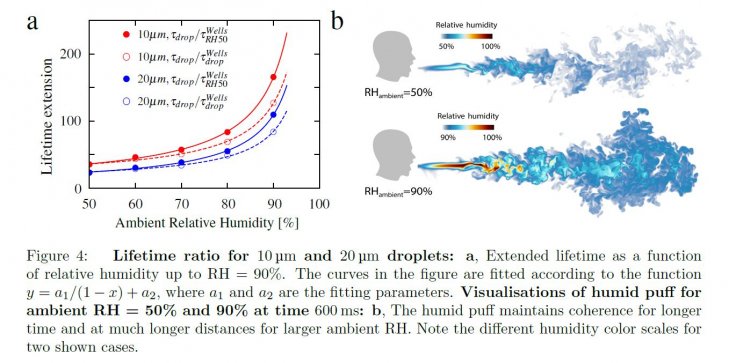The current understanding is that like other Coronaviruses, SARS-CoV-2 which causes COVID-19 is also airborne and can transmit through the floating aerosols. Thus, healthcare experts have urged people to wear masks and maintain social distancing. But as per a new study, the extent the droplets can travel is longer and can survive in relative humidity.
Initially, studies suggested that the virus when exhaled cannot survive longer and has a relatively short travel path in the air. But the new study, which was done by the researchers from the University of Twente and University of Rome Tor Vergata, claims that earlier assumptions might be incorrect. It says that smaller droplets can survive 50 times longer in 50 percent of humidity while in 90 percent humidity, it is up to 150 times.
"Our results may explain why COVID-19 superspreading events can occur for large ambient relative humidity such as in cooled-down meat-processing plants or in pubs with poor ventilation," researchers said in the new study.

Social Distancing Not Enough?
Hence, the two-meter or six feet social distancing rule is not adequate to avoid transmission. The social distancing method to curb the spread of the airborne virus was first introduced by William Wells in 1919 during the Spanish Flu pandemic. The theory was later applied to tuberculosis infection.
As per Wells, small droplets would evaporate quickly and transmission risk would be lower. As for the large droplets, it can transmit the virus within a meter of distance. But as per the new study, the droplets don't evaporate quickly as previously thought. It lasts longer — up to 10 minutes and spreads further — up to eight meters.
The reason is that when the droplets are expelled in warm and humid air, it takes time to dry out and that extends the infection period says Dr Liji Thomas. The droplets are released as a cloud and the lifetime of the droplets also depends on the mixing process with turbulent air.
Some studies have already pointed out the superspreaders or highly-infectious patients may spread the virus in a large distance. In addition, tiny droplets can increase the severity of the disease as the aerosols can enter deep into the lungs.

Role of Humidity in Spread
While the previous studies focused mainly on airborne modes of transmission and releveled that aerosols tend to be more infectious in indoor conditions, the role of humidity was not considered. The new study also takes into account the conditions such as ambient temperature, flow rate, humidity and distribution width of the droplets. All these conditions have a direct impact on the evaporation of the droplets and lifespan.
The researchers — Kai Leong Chong, Chong Shen Ng, Naoki Hori, Rui Yang, Roberto Verzicco and Detlef Lohse — conducted experiments simulating a turbulent puff of air into ambient air (34°Celcius) with 5,000 water droplets. The study also included hot air saturated with vapor to replicate a strong cough. They set the temperature of the air at 20°Celcius with a relative humidity of 50-90 percent to understand the underlying physics of evaporation of the droplets.

At 50 percent of relative humidity, the droplets over 100 μm (micrometer) traveled like a bullet because of the weight and evaporated faster. But the smaller droplets of 10 μm don't travel like the bigger ones and have a spiral tracing, meaning it is airborne and slower in speed due to its weight. It helps in covering a longer distance. At 50 percent relative humidity, it has 60 times longer life span than what is generally accepted and 200 times more in 90 percent of humidity.
The study recommends open-air settings and ventilation so that ambient temperature is higher. Also, lower humidity will be helpful in curbing the spread. But in many Asian countries, it is a monsoon season with high humidity that will impact the spread of the virus.
"We anticipate our tool and approach to be starting points for larger parameter studies and for optimizing ventilation and indoor humidity controlling concepts, which in the upcoming autumn and winter both will be key in mitigating the COVID-19 pandemic," the study said.









